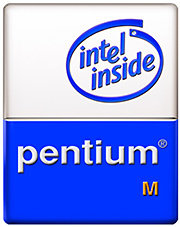Our website is made possible by displaying online advertisements to our visitors.
Please consider supporting us by disabling your ad blocker.
Pentium M
This article needs additional citations for verification. (December 2019) |
 Original logo (2003–2006) | |
| General information | |
|---|---|
| Launched | March 12, 2003 |
| Discontinued | July 14, 2009[1][better source needed] |
| Marketed by | Intel |
| Designed by | Intel |
| Common manufacturer |
|
| CPUID code | 695h (Banias) 0x6DX (Dothan) |
| Product code | Banias: 80535 Dothan: 80536 |
| Performance | |
| Max. CPU clock rate | 900 MHz to 2.26 GHz |
| FSB speeds | 400 MT/s to 533 MT/s |
| Data width | 64 bits |
| Address width | 36 bits |
| Virtual address width | 32 bits |
| Cache | |
| L1 cache | 64 KB (32 KB data + 32 KB instructions) |
| L2 cache | 1 MB or 2 MB, shared |
| Architecture and classification | |
| Application | Mobile |
| Technology node | 130 nm to 90 nm |
| Microarchitecture | P6 |
| Instruction set | x86-16, IA-32 |
| Extensions | |
| Physical specifications | |
| Transistors |
|
| Cores |
|
| Packages |
|
| Sockets |
|
| Products, models, variants | |
| Core names |
|
| Variant | |
| History | |
| Predecessor | Pentium 4 M |
| Successors | Intel Core (Yonah) Stealey |
| Support status | |
| Unsupported | |
The Pentium M is a family of mobile 32-bit single-core x86 microprocessors (with the modified Intel P6 microarchitecture) introduced in March 2003 and forming a part of the Intel Carmel notebook platform under the then new Centrino brand.[2] The Pentium M processors had a maximum thermal design power (TDP) of 5–27 W depending on the model, and were intended for use in laptops (thus the "M" suffix standing for mobile). They evolved from the core of the last Pentium III–branded CPU by adding the front-side bus (FSB) interface of Pentium 4, an improved instruction decoding and issuing front end, improved branch prediction, SSE2 support, and a much larger cache.
The Pentium M replaced the laptop version of the Pentium 4 (the Pentium 4-Mobile, or P4-M), which suffered from power consumption and heat problems. The first Pentium M–branded CPU, code-named Banias, was followed by Dothan.[3] The Pentium M line was removed from the official price lists in July 2009, when the Pentium M-branded processors were succeeded by the Core-branded dual-core mobile Yonah CPU with a modified microarchitecture.
- ^ "Product Change Notification #106928–02". Intel. December 27, 2006. Retrieved October 14, 2019.
- ^ Stokes, Jon (25 February 2004). "A Look at Centrino's Core: The Pentium M". Ars Technica. Retrieved 11 November 2019.
- ^ Shimpi, Anand Lal. "Intel's 90nm Pentium M 755: Dothan Investigated". www.anandtech.com. Retrieved 2019-12-05.
Previous Page Next Page


